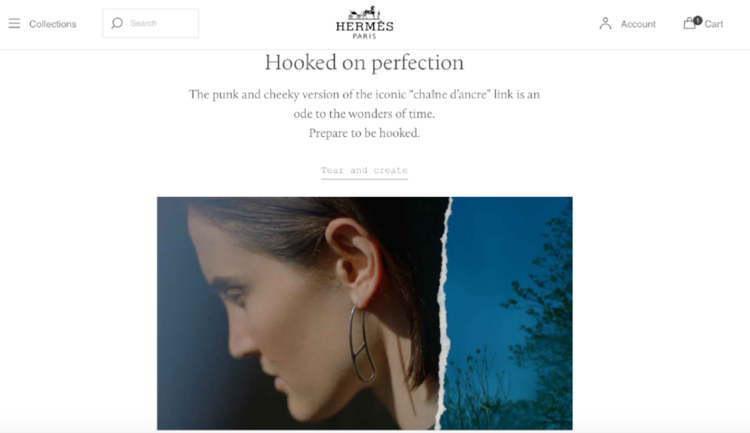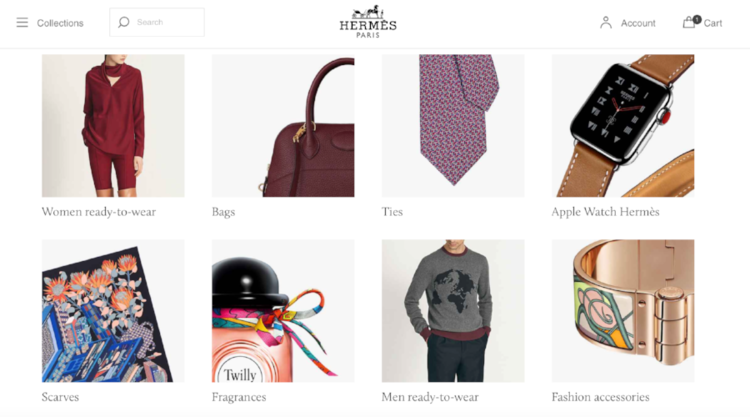
“The chicest thing is when you don’t exist on Google.” That is what Céline’s Phoebe Philo told Vogue in 2013. While it may have worked for the LVMH-owned brand – and others – five years ago, it is no longer the case. Need proof? Céline has launched an Instagram account and will, by the end of the year, be shoppable online, according to the brand.
Another indicator that luxury brands – even those that have been rather staunchly opposed to the world of e-commerce – are losing their stubborn battle? Hermès has a new website. Turns out, not even one of the market’s most established luxury brands – with its endlessly in-demand Birkin and Kelly bags, which will set you back a minimum of $7,000 – can withstand consumers’ demand for sophisticated e-commerce experiences.
Online sales have become the fashion industry’s most important and promising engine of growth. McKinsey & Company predicts that online sales of luxury goods will triple in the next 10 years, and that by 2025, the online share of total luxury sales will reach 18%.
As Chris Morton, chief executive of Lyst.com, told Reuters last year, “A luxury brand that avoids the internet is effectively refusing to engage with its customers where they are increasingly spending time and money. It is not listening to what its customers want, which is dangerous in any consumer-facing industry.”

With this in mind, “The question is no longer whether luxury brands should enter the digital world, but how,” says Nathalie Remy, a partner at McKinsey. It seems that even Hermès is not immune to such considerations.
Fighting for Profitability
The 180-year old brand, which warned last month that profitability probably has reached a peak and that the strong euro is set to erode 2018 sales of the company’s Birkin handbags and other luxury goods, began revamping its existing e-commerce site some time ago, testing it in Canada this summer, Hermès executives told analysts during a call last month.
If all goes well, Hermès’ plan to launch the new version of its site – which puts runway videos center stage, along with “stories” surrounding its products, whether it be its’ perfumers take in fragrances or the latest in the brand’s pop-up shop efforts – in Europe early next year and in Asia after that.
Its renewed foray into e-commerce is interesting for a few reasons, not least of which is its lackluster online presence to date. Prior to its web revamp, Hermès’ site served mostly as a one-dimensional hub for its scarves. Its new take on having an online presence appears to remedy this, as the new site places the spotlight on a larger array of its products. The new Hermes.com also incorporates much more significant consumer engagement elements (read: story-telling) – whether it be in the form of a diary devoted to its foundation or a look at its made-to-measure activities.
In short: It is essential for brands to pair content and commerce to create a fluid and consistent brand image throughout the site. This is something that Hermès is working to catch up on; its efforts have been described by analysts as “severely lacking” in recent years.
Big Spenders Online
Also of interest: The offerings themselves. As of now, consumers can get their hands on a whole slew of bags – over 300 styles – on Hermès’ site (that is nothing new), from its $3,00+ Evelyne II shoulder bag and Garden Party 36 bag.
As usual, what you will not find on that list: Birkin and Kelly bags, which must be purchased in-store, but that has everything to do with demand and nothing to do with price. In making available its medium Pliplat clutch, which sells for $49,400, and its small Double Sens 36 tote bag, which will set you back $30,400, among other pricey bags, Hermès is firmly on board with the rising notion that consumers are, in fact, willing to spend large sums online.

That is exactly what watchmaker Vacheron Constatin is banking on. As Forbes noted earlier this year, the Geneva-based company announced in February that it is partnering with New York-based website Hodinkee to sell its $45,000 Cornes de Vache 1955 timepieces online only. The release represents the first time in the brand’s 260-year history that the watchmaker will sell exclusively through the Internet.
This is also something Moda Operandi has been building its business upon. The New York-based e-commerce site, which offers runway garments and high-end jewelry and accessories, has consumers spending thousands of dollars per transaction on garments and accessories that in the past they would only buy in-store.
Moda Operandi’s Chief executive officer Deborah Nicodemus emphasized last year that Moda Operandi’s customers are “not just browsing” its $6,000 dresses and $32,890 pendants. “They’re pairing jewelry with evening gowns and occasion wear,” she says. And then pressing “Buy now.”
Hermès is not going all in online just yet (and judging by Moda Operadi’s recent efforts to open multiple showrooms around the world after relying exclusively on e-commerce since its founding in 2010, there is still value to brick-and-mortar). Nonetheless, its efforts seem promising, and it all really all goes back to something that Sara Gergovich, vice president of digital and ecommerce for Hermès, touched upon earlier this year during a luxury panel at Columbia University Business School, when she stated: “You really have to step back and say, ‘Where is my audience?’”
For Hermès (and all luxury brands, whether they like it or not), that is online.













